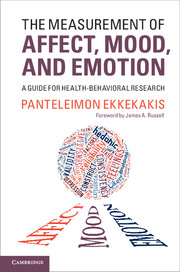Book contents
- Frontmatter
- Contents
- Figures
- Foreword
- Prologue
- 1 Documenting the breadth and depth of the problem
- 2 Untangling the terminological Gordian knot
- 3 Should affective states be considered as distinct entities or as positioned along dimensions?
- 4 Are pleasant and unpleasant states independent or polar opposites?
- 5 Selecting a measure
- 6 The old classics
- 7 Dimensional measures
- 8 Domain-specific measurement
- 9 Problems of domain specificity
- Epilogue
- References
- Index
9 - Problems of domain specificity
Examples from exercise
Published online by Cambridge University Press: 05 March 2013
- Frontmatter
- Contents
- Figures
- Foreword
- Prologue
- 1 Documenting the breadth and depth of the problem
- 2 Untangling the terminological Gordian knot
- 3 Should affective states be considered as distinct entities or as positioned along dimensions?
- 4 Are pleasant and unpleasant states independent or polar opposites?
- 5 Selecting a measure
- 6 The old classics
- 7 Dimensional measures
- 8 Domain-specific measurement
- 9 Problems of domain specificity
- Epilogue
- References
- Index
Summary
The challenges identified in Chapter 8 are common to many domain-specific measures. Since commenting on every single domain-specific measure that has appeared in the health-behavior literature would be impossible, this chapter focuses on three measures specifically developed to assess affective responses to exercise. Exercise represents an interesting example because this area has sparked the development of more domain-specific measures than perhaps any other health behavior. With more measures came more debate, more controversy, and more measurement-associated claims that can serve as the basis for illustrating some of the points made in Chapter 8. The problems identified, including the consequences of lacking a theoretical basis, the risks associated with construct underrepresentation, and the possible fallacies emanating from the notion of “sensitivity to change” are all highlighted in the critiques that follow. In turn, these critiques can serve as blueprints for evaluating most other domain-specific measures being used in health-behavioral research.
The Exercise-induced Feeling Inventory
The Exercise-induced Feeling Inventory (Gauvin & Rejeski, 1993) was developed on the basis of the fundamental assumption that “the stimulus properties of physical activity are capable of producing several distinct feelings states” (p. 404). The exploration of the domain of “distinct feeling states” associated with the “stimulus properties of physical activity” was motivated by the belief that commonly used measures, such as the Profile of Mood States, the Positive and Negative Affect Schedule, and the State-Trait Anxiety Inventory, “may have questionable content and construct validity in exercise research” (p. 404). The great challenge in developing the Exercise-induced Feeling Inventory was to delineate the nature, the limits, and the structure of its novel content domain.
- Type
- Chapter
- Information
- The Measurement of Affect, Mood, and EmotionA Guide for Health-Behavioral Research, pp. 155 - 167Publisher: Cambridge University PressPrint publication year: 2013



